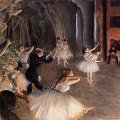Edgar Degas

 Edgar Degas, French painter and sculptor, known
especially for his paintings of ballet dancers. Other subjects that he
frequently returned to include horse races, women bathing, and
portraits of friends and relatives. Degas combined a modern focus on
the creation of unusual compositions and the rendering of movement
with a traditional emphasis on skillful drawing. Degas is usually
classed with the Impressionism, but he stood somewhat
apart from the other artists in this group. He did not share the
Impressionists' fascination with natural light and its effects, and he
disliked painting directly from nature, preferring instead to work in
the studio. Moreover, Degas had little interest in landscape - the
primary subject matter of the Impressionists - and concentrated
instead on the human figure. Also unlike the Impressionists, Degas was
interested in drawing and emphasized line in his work.
Edgar Degas, French painter and sculptor, known
especially for his paintings of ballet dancers. Other subjects that he
frequently returned to include horse races, women bathing, and
portraits of friends and relatives. Degas combined a modern focus on
the creation of unusual compositions and the rendering of movement
with a traditional emphasis on skillful drawing. Degas is usually
classed with the Impressionism, but he stood somewhat
apart from the other artists in this group. He did not share the
Impressionists' fascination with natural light and its effects, and he
disliked painting directly from nature, preferring instead to work in
the studio. Moreover, Degas had little interest in landscape - the
primary subject matter of the Impressionists - and concentrated
instead on the human figure. Also unlike the Impressionists, Degas was
interested in drawing and emphasized line in his work.
Life & work
Edgar Degas, French artist, acknowledged as the master of drawing the human figure in motion. Degas worked in many mediums, preferring pastel to all others. He is perhaps best known for his paintings, drawings, and bronzes of ballerinas and of race horses.
Degas came of the powerful upper bourgeoisie, his family having banking and business connections both in Italy and in the United States, and he was intended for the law, which he studied for a time after leaving the Lycee Louis-le-Grand. In 1855, however, he enrolled at the Ecole des Beaux-Arts and entered the studio of Louis Lamothe, a pupil of the painter Jean-Auguste-Dominique Ingres, whose long-established position as defender of academic orthodoxy in draftsmanship and subject matter was being challenged by the realism of Gustave Courbet as well as by the romanticism of Eugene Delacroix.
It seems likely that as a young man Degas wished to succeed along orthodox lines as a painter of historical subjects in the grand French tradition. To further his aim he augmented his studies by visiting Florence, Assisi, Rome, and Naples and by closely observing and copying the works of Andrea Mantegna, Sandro Botticelli, Hans Holbein the Younger, and Nicolas Poussin, all notable for their scrupulousness in figure draftsmanship.
Before 1860 Degas had produced some splendid family portraits in which the effect of this discipline, though clear, is heightened by a taut, alert urbanity that belongs unmistakably to the mid-19th century. The "Portrait of the Duchess of Morbilli" is typical of this group. It is broadly designed with large, simple surfaces rather flatly modeled in the manner of Ingres; the paint is solid, yet delicate, and the colours cool and restrained, with many black and neutral passages. In 1860 Degas made his debut as a painter of classical subjects with his "Young Spartans Exercising"; but here the nude figures, though arranged in balanced groups, are those of real adolescents in a natural landscape instead of idealized nudes in an Arcadian setting.
After 1861, when Degas painted "Semiramis Founding Babylon," again with academic intentions, he seems to have abandoned historical painting and begun to seek his subject matter in the fast-moving city life of Paris. In this he was probably inspired by contemporaries like Courbet and Edouard Manet (whom he met in 1862), by contemporary novelists, and by the discovery, late in the 1850s, of the astonishing formal yet documentary quality of Japanese graphic art. Nor did he overlook the brilliant work of contemporary French graphic artists such as Paul Gavarni and Honore Daumier.
 It is not surprising that
by 1862 he was painting the riders, their mounts, and the smart
spectators at Longchamp racecourse, soon afterward beginning the
portrait groups of musicians and stage subjects, which, like all
subjects in which the sitters were absorbed in practiced movement,
fascinated him throughout his life. Among the first of the latter is
the "Mlle Fiocre in the Ballet 'La Source'." His portraits of the
1870s show greater ease and naturalism than the very first group but
are still based on a discipline traceable to Holbein and the great
north Italian portraitists.
It is not surprising that
by 1862 he was painting the riders, their mounts, and the smart
spectators at Longchamp racecourse, soon afterward beginning the
portrait groups of musicians and stage subjects, which, like all
subjects in which the sitters were absorbed in practiced movement,
fascinated him throughout his life. Among the first of the latter is
the "Mlle Fiocre in the Ballet 'La Source'." His portraits of the
1870s show greater ease and naturalism than the very first group but
are still based on a discipline traceable to Holbein and the great
north Italian portraitists.
Degas served in the artillery during the Franco-German War of 1870-71. On his return, he began to undertake ambitious figure groups, seen informally and in movement, and continued his studies of stage and orchestral groups. From these he passed to instantaneous renderings of both outdoor and indoor scenes, using displaced figure grouping and unorthodox cutting and perspective rather in the manner of a cameraman. Yet his magnificent formal sense and skill is always present to provide an equilibrium, however momentary, to these exacting subjects.
The "Place de la Concorde (Vicomte Lepic and His Daughters)" is a fine example and an outdoor counterpart to the ballet subjects that gave Degas endless scope for multifigure groups seen in fast intercepted movement. Degas visited the United States in October 1872, staying for five months and painting one of his best-known scenes of figures in absorbed "occupational" movement. This was the "New Orleans Cotton Office" of 1873; it shows that although Degas had completely abandoned his early ambition of historical figure painting, he had, nevertheless, put to full use the structural principles of the formal tradition.
During the 1870s, most of Degas's figure groups were arranged against fairly extended background space, in which the figures themselves were given plenty of room. By the end of the decade, however, he was becoming interested in the pictorial possibilities of more closely juxtaposed and superimposed groups and giving more attention to the formal qualities of the voids between them. The famous "Repasseuses" ("Two Laundresses") of 1884 shows this tendency at an advanced stage, with an artificially shallow picture space and a reconciliation of solid form and surface reminiscent of Venetian mid-16th-century art in method but here applied with a documentary eye to a casual workaday subject.
By this time Degas had begun to work in pastel, sometimes using a mixed technique with volatile oil mediums, and his indoor series of women at their ablutions carries on the researches mentioned above. Some of the later ones reach an astonishing compromise between plasticity and surface pattern, the flesh colours being built up of strips of pure colour more closely knit than the taches of the Impressionists but, like them, merging at a certain distance to give the illusion of solid modeling.
After 1880 Degas was practicing occasionally as a sculptor, and a group of small bronzes deriving from his models of dancers, bathing women, and horses again show his power of revealing the potentialities of the ordinary unobserved movements of human beings and animals. Degas, in fact, perhaps for the first time in history, viewed his animal and human models with the same dispassionate eye when making these studies. He was interested in photography, and there is an affinity between his vision and that of a high-speed camera. Degas's eyesight failed in later life; he became completely blind in one eye and nearly so in the other. At his death he left an important collection of the drawings and paintings of his contemporaries and a notebook of poetic compositions, mostly in sonnet form.
© D. T., E. B.
Edgar Degas Art

|
|
More
Articles
 Art Encyclopedia A world history of art in articles.
Art Encyclopedia A world history of art in articles.
Impressionism
Edgar Degas
Life and work.
Art
 Art Wallpapers Art image collections for your desktop.
Art Wallpapers Art image collections for your desktop.
Monet Art, $35
(250 pictures)
Degas Art, $25
(170 pictures)
Renoir Art, $39
(300 pictures)
